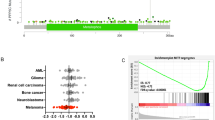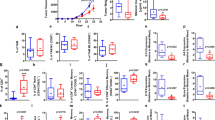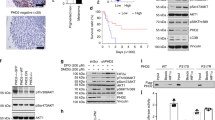Abstract
Purpose
We examined the expression of PPARs and the effects of PPARα and PPARγ agonists on growth of mouse and human melanocytes and melanoma cells.
Methods
PPARα,β, and PPARγ mRNA qualitative expression in melan-a mouse melanocytes, B16 mouse melanoma, human melanocytes, and A375 and SK-mel28 human melanoma cells was determined by RT-PCR, while quantitative PPARα mRNA levels were determined by QuantiGene assay. PPARα and PPARγ protein was assessed by Western blotting. The effect of natural and synthetic PPAR ligands on cell growth was determined by either hemocytometer counting or crystal violet assay. PPAR transcriptional activity was determined by a PPRE-reporter gene assay, while knockdown of PPARα expression was achieved by transient transfection of siRNA.
Results
Both mouse and human melanoma cells produced more PPARα and PPARγ protein compared to melanocytes. PPARα mRNA levels were elevated in human melanoma cells, but not in mouse melanoma cells relative to melanocytes. Silencing of PPARα in human melanoma cells did not alter cell proliferation or morphology. PPARγ-selective agonists inhibited the growth of both mouse and human melanoma cells, while PPARα-selective agonists had limited effects.
Conclusion
Increased expression of PPARα in melanoma relative to melanocytes may be a common occurrence, however its biologic significance remains to be determined. PPARγ agonists may be useful for arresting the growth of some melanomas.






Similar content being viewed by others
Abbreviations
- CDK:
-
cyclin depdendent protein kinase
- GAPDH:
-
glyceraldehyde phosphate dehydrogenase
- MCAD:
-
medium chain acyl CoA dehydrogenase
- PPAR:
-
peroxisome proliferator activated receptor
- PPRE:
-
peroxisome proliferator response element
References
S. Green. PPAR a mediator of peroxisome proliferator action. Mutat. Res. 333:101–109 (1995).
P. Eschser, and W. Wahli. Peroxisome proliferators-activated receptors: insight into multiple cellular functions. Mutat. Res. 448:121–138 (2000).
J. Berger, and D. E. Moller. The mechanisms of action of PPARs. Annu. Rev. Med. 53:409–435 (2002).
E. Mueller, P. Sarraf, P. Tontonoz, R. M. Evans, K. J. Martin, M. Zhang, C. Fletcher, S. Singer, and B. M. Spiegelman. Terminal differentiation of human breast cancer through PPAR γ. Mol. Cell 3:465–479 (1998).
S. Kawa, T. Nikaido, H. Unno, N. Usuda, K. Nakayama, and K. Kiyosawa. Growth inhibition and differentiation of pancreatic cancer cell lines by PPAR γ ligand troglitzaone. Pancreas 24:1–7 (2002).
G. He, S. Muga, P. Thuillier, R. A. Lubet, and S. M. Fischer. The effect of PPAR ligands on UV- or chemically induced carcinogenesis in mouse skin. Mol. Carcinog. 43:198–206 (2005).
G. Boskovic, and R. M. Niles. Identification of Tbx-2 as an immediate early gene target of retinoic acid in B16 mouse melanoma cells. Exp. Cell Res. 295:281–289 (2004).
H. Okano, K. Shiraki, H. Inoue, Y. Yamanaka, T. Kawakita, Y. Saitou, Y. Yamaguchi, N. Enokimura, N. Yamamoto, K. Sugimoto, K. Murata, and T. Nakano. 15-Deoxy-delta-12–14-PGJ2 regulates apoptosis induction and nuclear factor-kappaB activation via a peroxisome proliferators-activated receptor-γ-independent mechanism in hepatocellular carcinoma. Lab. Invest. 83:1529–1539 (2003).
C. S. Aung, H. M. Faddy, E. J. Lister, G. R. Moneith, and S. J. Roberts-Thomson. Isoform specific changes in PPAR α and β in colon and breast cancer with differentiation. Biochem. Biophys. Res. Commun. 340:656–660 (2005).
Y. Segawa, R. Yoshimura, T. Hase, T. Nakatani, S. Wada, Y. Kawahito, T. Kashimoto, and H. Sano. Expression of peroxisome proliferaor activated receptor (PPAR) in human prostate cancer. Prostate 51:108–116 (2002).
K. Inoue, Y. Kawahito, Y. Tsubouchi, R. Yamada, M. Kohno, Y. Hosokawa, D. Katoh, D. Bishop-Bailey, T. Hla, and H. Sano. Expression of peroxisome proliferators-activated receptor (PPAR)-γ in human lung cancer. Anticancer Res. 21:2471–2476 (2001).
T. Nijsten, E. Geluyckens, C. Colpaert, and J. Lambert. Peroxisome proliferators-activated receptors in squamous cell carcinoma and its precursors. J. Cutan. Pathol. 32:340–347 (2005).
K. M. Suchanek, F. J. May, J. A. Robinson, W. J. Lee, N. A. Holman, G. R. Monteith, and S. J. Roberts-Thomson. Peroxisome proliferators-activated receptor α in the human breast cancer cell lines MCF-7 and MDA-MB-231. Mol. Carcinog. 34:165–171 (2002).
P. Tontonoz, S. Singer, B. M. Forman, P. Sarraf, J. A. Fletcher, C. D. Fletcher, R. P. Vrun, E. Mueller, S. Altiok, H. Oppenheim, R. M. Evans, and B. M. Spiegelman. Terminal differentiation of human liposarcoma cells induced by ligands for peroxisome proliferator-activated receptor γ and the retinoid X receptor. Proc. Natl. Acad. Sci. U.S.A. 94:237–241 (1997).
C. Zang, H. Liu, M. Waechter, J. Eucker, J. Bertz, K. Possinger, H. P. Koeffler, and E. Eistner. Dual alpha/gamma ligand TZD18 either alone or in combination with imatinib inhibits proliferation and induces apoptosis of human CML cell line. Cell Cycle 5:2237–2247 (2006).
R. T. Miller, S. E. Glover, W. S. Stewart, J. C. Corton, J. A. Popp, and R. C. Cattley. Effect on the expression of c-met, c-myc and PPAR-α in liver and liver tumors from rats chronically exposed to the hepatoccarcinogenic peroxisome proliferators WY-14,643. Carcinogenesis 17:1337–1341 (1996).
J. W. Park, R. Zarnegar, H. Kanauchi, M. G. Wong, W. C. Hyun, D. G. Ginzinger, M. Lobo, P. Cotter, Q. Y. Duh, and O. H. Clark. Troglitzaone, the peroxisome proliferators-activated receptor-γ agonist, induces antiproliferation and redifferentiation in human thyroid cancer cell lines. Thyroid 15:222–231 (2005).
N. Di-Poi, L. Michalik, B. Desvergne, and W. Wahli. Functions of peroxisome proliferators-activated receptors (PPAR) in skin homeostasis. Lipids 39:1093–1099 (2004).
L. Michalik, J. N. Feige, L. Gelman, T. Pedrazzini, H. Keller, B. Desvergne, and W. Wahli. Selective expression of a dominant-negative form of peroxisome proliferators-activator receptor in keratinocytes leads to impaired epidermal healing. Mol. Endocrinol. 19:2335–2348 (2005).
H. Y. Kang, E. Chung, M. Lee, T. Cho, and W. H. Kang. Expression and function of peroxisome proliferators-activated receptors in human melanocytes. Br. J. Dermatol. 150:462–468 (2004).
W. Plachaa, D. Gil, A. Dembinska-Kiec, and P. Laidler. The effect of PPAR γ ligands on the proliferation and apoptosis of human melanoma cells. Melanoma Res. 13:447–456 (2003).
C. Freudlsperger, I. Moll, U. Schumacher, and A. Thies. Anti-proliferative effect of peroxisome proliferators-activated receptor γ agonists on human malignant melanoma cells in vitro. Anticancer Drugs 17:325–332 (2006).
J. S. Lee, Y. M. Choi, and H. Y. Chang. PPAR-γ agonist, ciglitazone, increases pigmentation and migration of human melanocytes. Exp. Dermatol. 16:118–123 (2007).
M. Selmandi, G. Lemaire, A. Pillon, A. Perrin, I. Carlavan, J. J. Voegel, F. Vignon, J. C. Nicolas, and P. Balaquer. Differential responses to PPARα, PPARδ, an PPARγ reporter cell lines to selective PPAR synthetic ligands. Anal. Biochem. 344:8–15 (2005).
C. L. Chaffer, D. M. Thomas, E. W. Thompson, and E. D. Williams. PPAR γ-independent induction of growth arrest and apoptosis in prostate and bladder carcinoma. BMC Cancer 6:53 (2006).
Y. Liu, Y. Meng, H. Liu, J. Li, J. Fu, Y. Liu, and K. Chen. Growth inhibition and differentiation induced by peroxisome proliferators activated receptor γ ligand rosiglitazone in human melanoma cell line a375. Med. Oncol. 23:393–402 (2006).
Acknowledgement
The authors would like to thank Dr. Zalfa Abdel-Malik, University of Cincinnati, for supplying human melanocyte cultures for some of our initial studies. We also thank Margaret McFarland for preparing the figures. This study was supported in part by grants CA59530 from the NCI, NIH, CA59539/S from the MARC program NIH, and P20 RR20180 from the Division of Research Resources, NIH.
Author information
Authors and Affiliations
Corresponding author
Rights and permissions
About this article
Cite this article
Eastham, L.L., Mills, C.N. & Niles, R.M. PPARα/γ Expression and Activity in Mouse and Human Melanocytes and Melanoma Cells. Pharm Res 25, 1327–1333 (2008). https://doi.org/10.1007/s11095-007-9524-9
Received:
Accepted:
Published:
Issue Date:
DOI: https://doi.org/10.1007/s11095-007-9524-9




